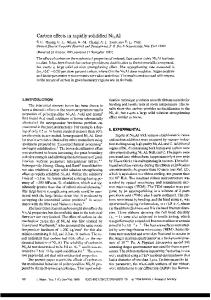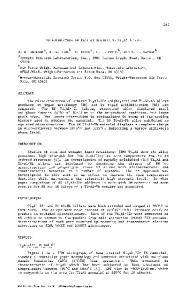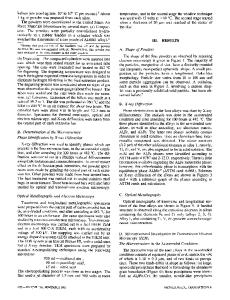Rapidly solidified Al 3 Ti-base alloys containing Ni
- PDF / 878,746 Bytes
- 7 Pages / 593.28 x 841.68 pts Page_size
- 102 Downloads / 427 Views
Rapidly solidified Al3Ti-base alloys containing Ni S.C. Huang, E.L. Hall, and M. F. X. Gigliotti General Electric Corporate Research and Development, P.O. Box 8, Schenectady, New York, 12301 (Received 15 June 1987; accepted29 September 1987) Two Ni-modified Al3Ti alloys (Al 65 Ni 10 Ti 25 and Al62Ni8Ti3O) were rapidly solidified by melt spinning. The resulting microstructure was studied using light microscopy and analytical electron microscopy. Significant variations in the microstructure and phases were observed between the two ribbons and through the thickness of each ribbon. A single-phase y-TiA\ structure was seen near the wheel side of the Al 52 Ni 8 Ti 30 ribbon, having rnicrocrystalline grains ~ 100 nm in diameter. Second-phase particles of A-AlNiTi were found in the remaining regions of that ribbon as the structure became columnar due to reduced rates of cooling. The Al55Ni10Ti25 alloy exhibited a primary phase of TT-A16 5 NiTi2 s. A second phase of^-Al 2 NiTi formed with morphology and distribution varying through thickness. Microchemistry measurements on the phases indicated substantial deviations (up to 14 at. %) from the stoichiometric compositions. Further, the n, A, and/i are low-temperature phases that do not form by solidification under equilibrium conditions. The observation of these phases thus suggests significant undercoolings achieved during the melt-spinning processing of the present alloys. Both ribbons are brittle as spun.
I. INTRODUCTION The Al3 X compounds with X equal to Ti, Hf, V, Nb, and Ta deserve attention for their potential structural applications at high temperatures. These ordered intermetallics have attractive combinations of properties such as low density, high melting temperature, and good oxidation resistance. They also have the tetragonal D 022 structure, which is related to the cubic L 12 by essentially displacing every (001) plane by a vector of 1/2 [110]. According to semiempirical correlations,1'2 a D 022-to-Z, l 2 transition is possible with relatively minor adjustments in the atomic size, valence, and electronegativity differences between X and Al. This is particularly interesting, since the face-centered-cubic L\2 structure is generally considered more deformable than D 0 22 . Several L 12 compounds such as Cu3 Au 3 and Co 3 Ti4 are ductile; at least one, Ni3 Al, which is otherwise brittle like many intermetallics, has been successfully ductilized.5"7 The L 12 structures based on A13X have been observed previously. Metastable L l 2 -type Al 3 Hf was found to precipitate in aged Al-base alloys.8 The precipitates were coherent to the matrix and could sustain prolonged aging (e.g., 100 h at 400 °C) before transformation to the equilibrium D022 structure. Rapid solidification resulted in supersaturation, thus enhancing the L 12 precipitation and the associated strengthening effect.9 Equilibrium L 12 phases were also reported in several AlyXsystems containing the ternary elements Ni, Cu, and Zn. 1 0 " One example is the Al 65 NiTi 2 5 phase,12 in which the 10 at. % Ni subs
Data Loading...











